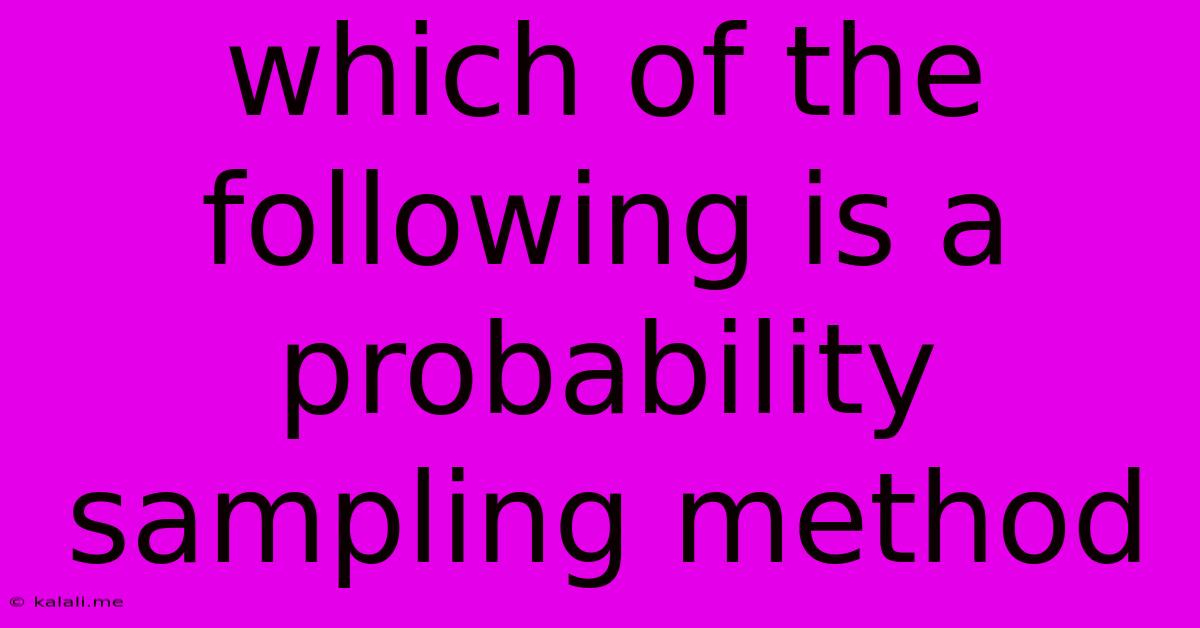Which Of The Following Is A Probability Sampling Method
Kalali
Jun 16, 2025 · 3 min read

Table of Contents
Which of the Following is a Probability Sampling Method? Understanding Probability vs. Non-Probability Sampling
Choosing the right sampling method is crucial for conducting reliable research. This article will explore the core differences between probability and non-probability sampling, highlighting why probability sampling is preferred for generating statistically generalizable results. We'll then delve into the specific types of probability sampling methods, helping you understand which one best suits your research needs. This guide is designed to empower you to make informed decisions when designing your research methodology.
What is Probability Sampling?
Probability sampling, also known as random sampling, is a sampling technique where each member of the population has a known, non-zero chance of being selected for the sample. This ensures that the sample is representative of the population, minimizing sampling bias and allowing for the generalization of findings to the larger group. This is vital for quantitative research aiming for statistically significant conclusions.
Key Characteristics of Probability Sampling:
- Random Selection: The foundation of probability sampling is the random selection of participants. This can be achieved through various techniques (discussed below).
- Known Probability: Each member of the population has a calculable probability of being selected.
- Generalizability: Results obtained from a probability sample can be generalized to the larger population with a known margin of error.
- Reduced Bias: The random selection process minimizes the risk of researcher bias influencing sample selection.
Types of Probability Sampling Methods:
Several methods fall under the umbrella of probability sampling, each with its own strengths and weaknesses:
-
Simple Random Sampling: Every member of the population has an equal and independent chance of being selected. This is often done using random number generators or lottery methods. This is the most straightforward but can be impractical for large populations.
-
Stratified Random Sampling: The population is divided into subgroups (strata) based on relevant characteristics (e.g., age, gender, location). A random sample is then taken from each stratum, ensuring representation from all subgroups. This improves the accuracy of representation compared to simple random sampling, especially when dealing with heterogeneous populations.
-
Cluster Sampling: The population is divided into clusters (e.g., geographical areas, schools), and a random sample of clusters is selected. All members within the selected clusters are then included in the sample. This method is cost-effective for large, geographically dispersed populations but may lead to higher sampling error.
-
Systematic Sampling: Every kth member of the population is selected after a random starting point. While seemingly simple, it's crucial the population list is randomly ordered to avoid bias. This method is efficient but can be problematic if there's a pattern in the population list.
Non-Probability Sampling: A Contrast
In contrast to probability sampling, non-probability sampling methods do not give every member of the population a known chance of selection. This means the sample may not accurately reflect the population, and findings cannot be generalized with the same confidence. Examples include convenience sampling, snowball sampling, and quota sampling. While easier and sometimes cheaper, these methods are susceptible to bias and limit the generalizability of results.
Choosing the Right Method:
The optimal probability sampling method depends on several factors:
- Research Objectives: What questions are you trying to answer?
- Population Size and Accessibility: How large is your population, and how easy is it to access?
- Resources: What is your budget and timeframe?
- Desired Level of Accuracy: How much precision do you require in your results?
By carefully considering these factors and understanding the strengths and weaknesses of each probability sampling method, you can choose the approach that best suits your research needs and ensures the reliability and validity of your findings. Remember, while non-probability sampling has its uses, probability sampling is the gold standard for generating statistically sound and generalizable results.
Latest Posts
Latest Posts
-
How To Create Clickable Image In Html
Jun 16, 2025
-
What Are The Factors Of 121
Jun 16, 2025
-
What Is A Theme Of The Passage
Jun 16, 2025
-
A Company That Provides Access To The Internet
Jun 16, 2025
-
Which Word Is Closest In Meaning To The Underlined Word
Jun 16, 2025
Related Post
Thank you for visiting our website which covers about Which Of The Following Is A Probability Sampling Method . We hope the information provided has been useful to you. Feel free to contact us if you have any questions or need further assistance. See you next time and don't miss to bookmark.